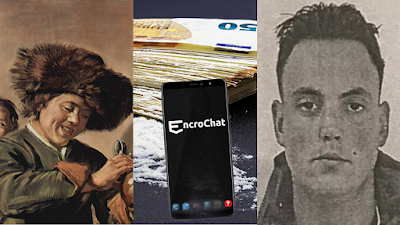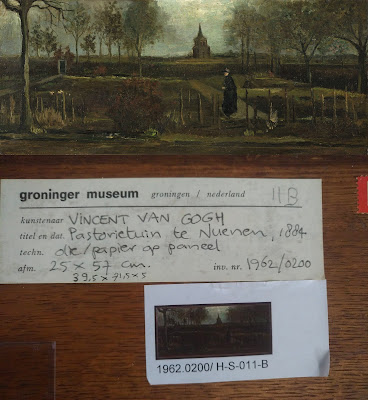 Belgium,EncroChat,Flor B.,Organised Crime,Raffaele Imperiale,SKY ECC,Switzerland,Transnational crime,Vincent van Gogh
Belgium,EncroChat,Flor B.,Organised Crime,Raffaele Imperiale,SKY ECC,Switzerland,Transnational crime,Vincent van Gogh
 No comments
No comments
The Bongoking and the brushstroke: How a drug lord’s alleged art deal links a crime syndicate to a stolen masterpiece
In the tangled web of organised crime, illicit art dealings can sometimes serve as both currency and collateral. The ongoing trial of "Flor B.,"a Belgian national with a shocking criminal resume and a growing reputation as one of Europe's most dangerous narco-traffickers, has taken a dramatic turn into the world of cultural crime. Dubbed the “Bongoking” in encrypted chat logs, this individual has been linked by prosecutors to the high-profile theft of Two Laughing Boys with a Mug of Beer, a 17th-century masterpiece by Dutch Golden Age painter Frans Hals, stolen on 26 August 2020 from the Hofje van Mevrouw van Aerden Museum in Leerdam, housed on the Kerkstraat.
The first lead on this case came in early 2021, when White Hat cyber-exploit hackers in the European police cracked SKY ECC's EncroChat encryption software, a chat service app that only ran on specially configured Nokia, Google, Apple and BlackBerry phones. Listening in, the law enforcement officers struck intelligence gold. By 2023, officers had intercepted some 115 million criminal conversations, by an estimated 60,000 users in which criminals openly negotiated, sometimes in extremely granular detail, money laundering, murders, counterfeiting, drugs, and firearms trafficking.
In some of these messages and voice recordings, shared both in group chats and one-on-one conversations, members of this drug network coordinated cocaine shipments, talked about their connections with South America drug barons, bragged about violent exploits, and discussed the recent high-profile art theft.
Just two weeks after the museum theft in Leerdam, in messages from the police-cracked app which are now part of trial records, occurred between an individual going by the chat handle Bongoking (Flor B's alleged pseudonym) who discussed the recently filched 17th-century painting, bragging about negotiating a lower purchase price.
In selected texts released to the public Bongoking writes:
“I recently bought a Frans Hals, 2 laughing boys,”
“Paid dearly, brother… Asked for 750, settled for 550.”
Authorities believe this figure represents €550,000, the price the speaker paid for the stolen painting. He chillingly outlines the painting's purpose in the same chat: not as a collector’s trophy, but as a strategic asset—something to potentially barter for leniency in relation to his wife's role in the criminal's illegal affairs.
“It won’t work for me, brother. But I might still be able to keep my wife out of jail with it, you know,” he wrote, anticipating his own eventual downfall.
He also talked about his construction of a private airport in Equatorial Guinea, used to exploit a shipping loophole which allowed cocaine to flow more easily into the Benelux as part of the kingpin's rapidly expanding criminal enterprise.
Already a fugitive from justice, the discerning kingpin was in hiding in Switzerland, where for 20 months, he is alleged to have run his international drug cartel from various luxury properties unchallenged. To do so he used the names Artur Gitta or later Georgios Kandylidis. His wife for her part became known first as Simone Jung and then as Alexandra Sapranova. That is until shortly before midnight on 16 February 2022 when both their crime-filled lives caught up with them.
Following an intensive manhunt, Flor B. and his wife were arrested at a luxury 22nd floor apartment in the exclusive Renaissance residence (Mobimo Tower) in the heart of Zürich West. The couple's infant son was sleeping in his crib in the next room when law enforcement officers raided the highrise.
Taken into custody, Flor B will be held at the Pöschwies correctional facility for eight months before being extradited to Belgium where he is placed in solitary confinement at Poort van Beveren, a state of the art, high security penal institution while his case in Begium proceeds. His wife is initially held at the Dielsdorf women's prison in special prison accommodation for offenders with small children. She will remain there for eight months before being released, and subsequently also extradited to Belgium.
Flor B's legal team, led by attorney Yehudi Moszkowicz, disputes the prosecution’s interpretation of the messages related to the stolen painting. Moszkowicz insists his client denies authorship of the incriminating texts and criticises the one-sided nature of the evidence, pointing out the absence of full chat transcripts, as well as the identity of the recipient. “These chats do not show that the sender of the messages actually has access to the painting,” he argued, suggesting the possibility of exaggeration.
But this is far from Flor B’s only serious criminal allegation. The breakthrough in the SKY ECC cryptophone app exposed this network's trafficking operations, which investigators say revealed the young man as a central figure in a massive European drug empire. His purported alias Bongoking surfaced repeatedly in communications linked to the importation of more than 16 tons of cocaine, valued at €400 million. The message also allegedly tie him to violent networks in South America and the Netherlands. Among the most startling revelations is his alleged orchestration of a drug smuggling scheme using Kriva Rochem, an Antwerp-based water treatment firm that doubled as a front business for cocaine importation.
In closing, the alleged link between Flor B., and his potential connection to the Frans Hals painting is remarkably similar to the thefts of two Van Gogh paintings which ended up in the hands of Camorra-linked mafia boss Raffaele Imperiale. Likewise last December Stefan Papić, a member of the drug cartel Tito and Dino and considered to be the right-hand man of Flor B was arrested on the basis of a warrant from Belgium. Papić had opened an art gallery Puro Arte in Breda which is suspected of being used to launder the proceeds of crime. All three illustrate transnational organised crime figures who are members of massive drug cartels and who dabbled in the world of artistic works with the motivation of using them to launder the proceeds of crime, or use them as collateral or leverage in negotiations, whether in backrooms, on smart phones, or ultimately, in courtrooms during plea deals.
Unfortunately as Flor B's trial continues, the Frans Hals painting remains missing and its fate remains uncertain. What we do know is that its value is immense not only in monetary terms but as a documented example of how deeply organised crime can entrench itself in the cracks of legitimate society. Whether hanging in museums or hidded in a drug lord's hideaway, the convergence of fine art and criminal finance continues to challenge the boundaries of law enforcement, and the integrity of the art world itself.


















